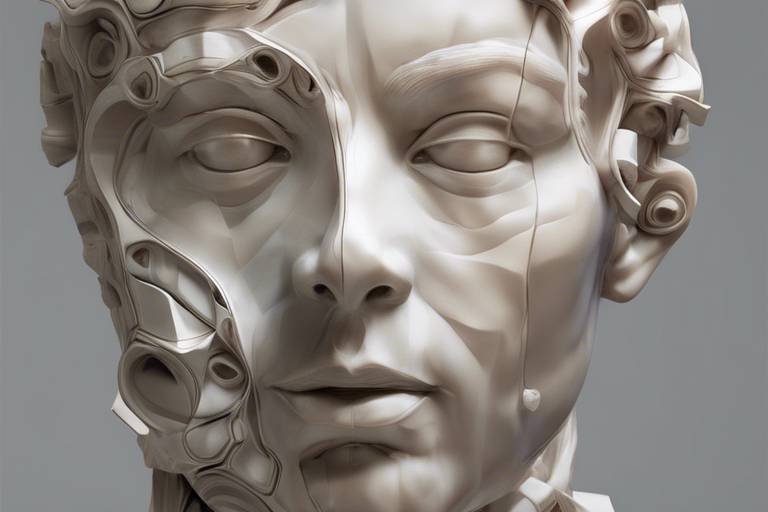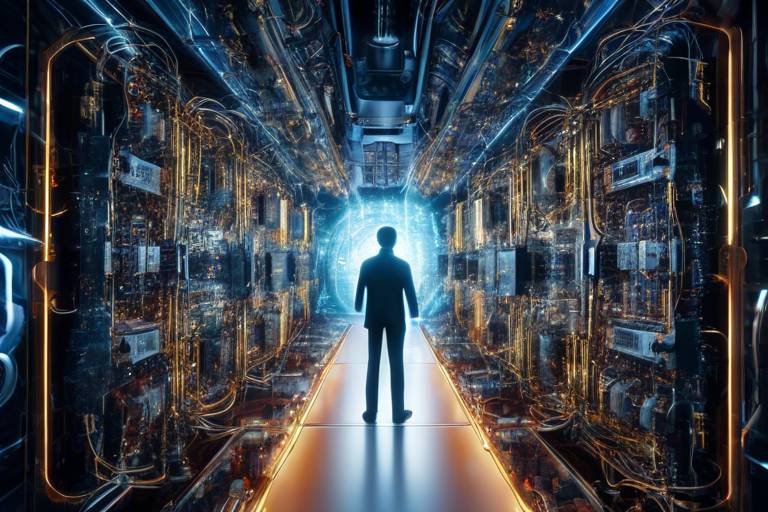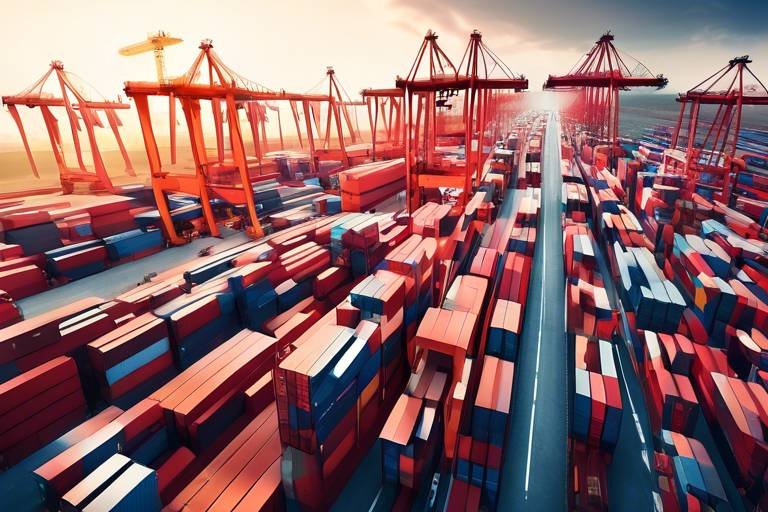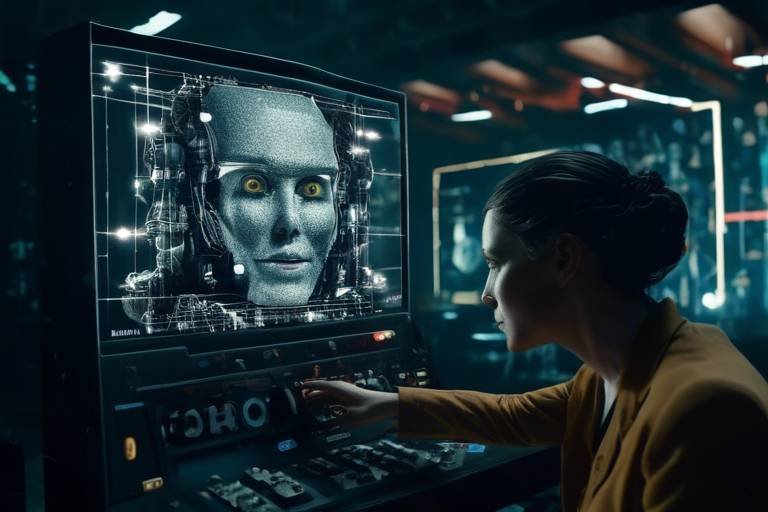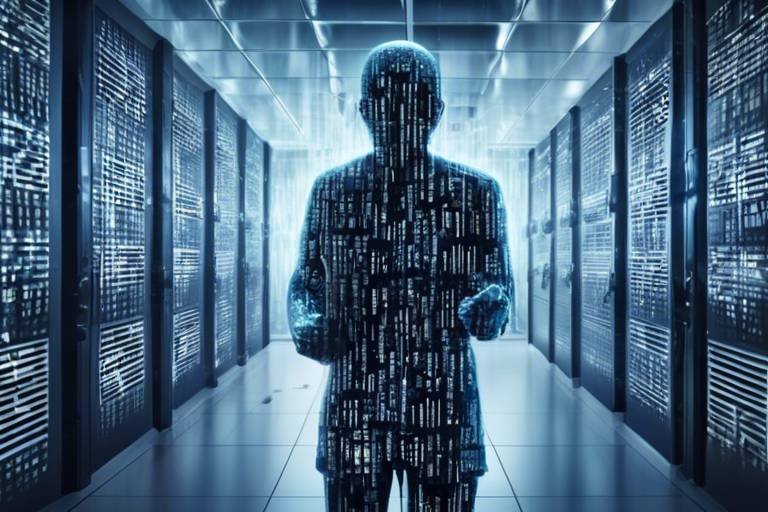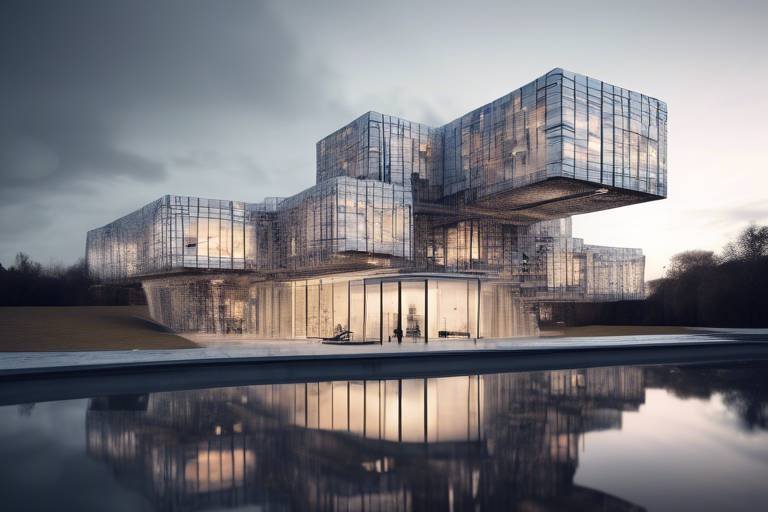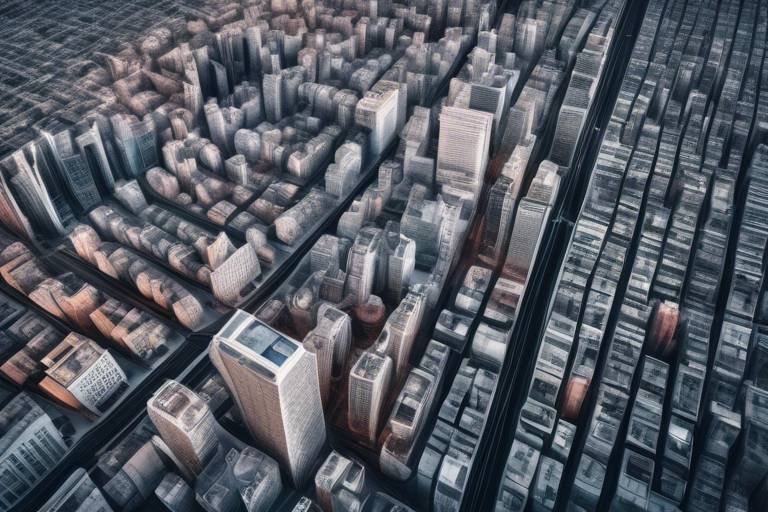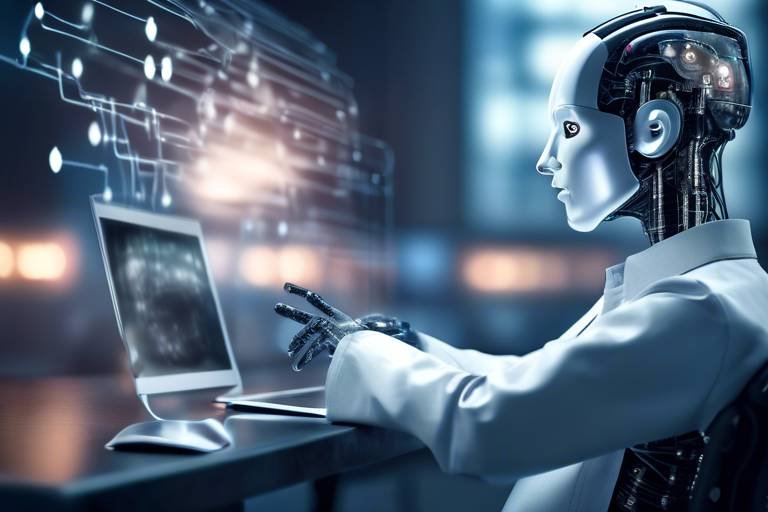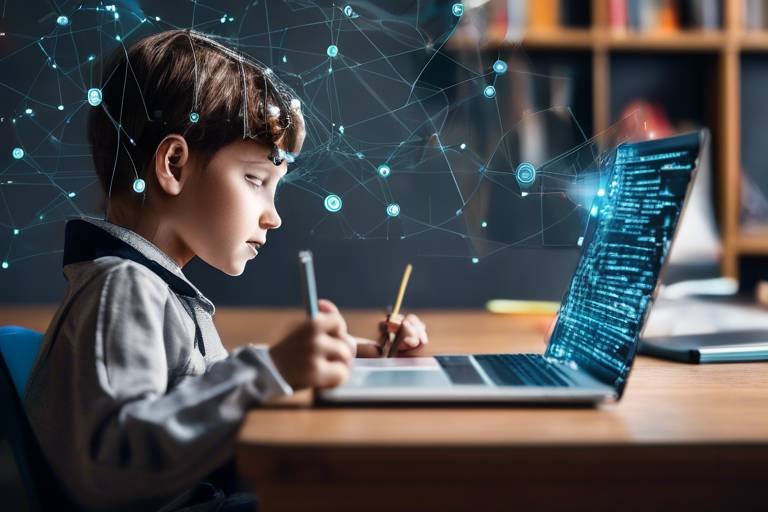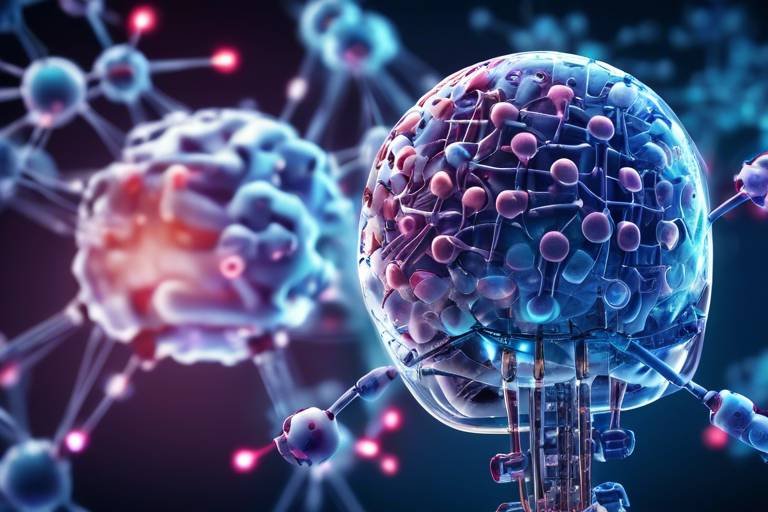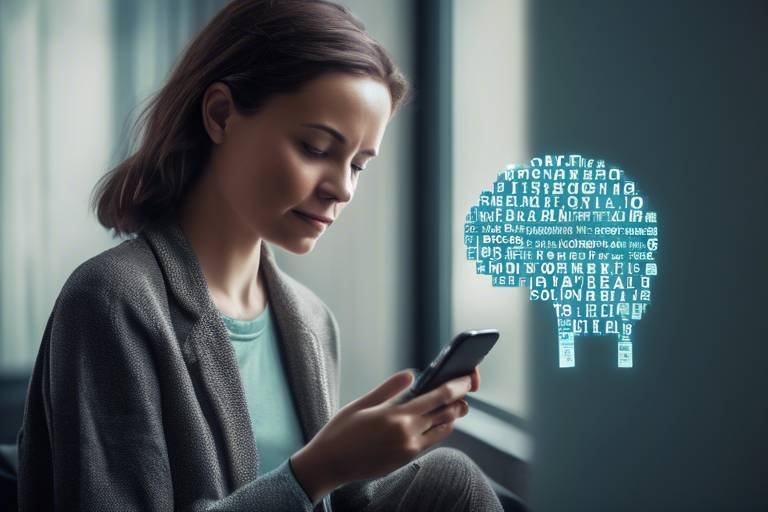AI in Sculpting: A New Era in Art
In recent years, the intersection of art and technology has sparked a revolution, and nowhere is this more evident than in the world of sculpting. As we stand on the brink of a new era, artificial intelligence (AI) is not just a tool; it’s a collaborator, a muse, and a game-changer for artists. Imagine walking into a studio where the lines between human creativity and machine intelligence blur, creating a dynamic environment ripe for innovation. This article explores the transformative impact of AI on sculpting, highlighting innovative techniques, creative collaborations, and the exciting future of artistic expression in our technology-driven world.
AI is reshaping traditional sculpting methods, allowing artists to experiment with new materials and processes. Think of it as a powerful ally that enhances creativity and efficiency in sculptural practices. For instance, artists can now utilize AI to analyze their past works, identifying patterns and styles that resonate with audiences. This not only helps in refining their techniques but also opens the door to experimenting with unconventional materials like biodegradable plastics or recycled metals. The result? A fusion of sustainability and artistry that speaks to the modern viewer's sensibilities.
The emergence of AI-powered design software is changing how sculptors conceptualize their work. These tools allow artists to visualize and refine their ideas long before they touch the material. Imagine being able to sketch a concept and instantly see how it would look in 3D, or even better, how it would interact with its environment. This not only saves time but also fuels the creative process, enabling artists to explore multiple iterations of a design without the constraints of physical limitations.
3D modeling software integrated with AI algorithms is revolutionizing sculpting. With the ability to create intricate designs and prototypes with unprecedented precision, artists can push the boundaries of what’s possible. For example, AI can assist in simulating how different materials react to various environmental factors, ensuring that the final product is not only visually stunning but also structurally sound. This technological advancement is akin to having a highly skilled assistant who tirelessly works alongside the artist, suggesting improvements and offering insights.
Generative design uses AI to produce unique forms based on specified parameters. It’s like giving a sculptor a set of rules and letting them unleash their imagination. Sculptors can input criteria such as size, shape, and even emotional tone, allowing the AI to generate a plethora of design options. This technique pushes the boundaries of artistic vision, enabling artists to explore forms they may not have considered otherwise. The result is a stunning array of sculptures that are not just beautiful but also deeply innovative.
AI is facilitating interactive experiences in sculpture, making art more engaging for audiences. Imagine walking into a gallery where the sculptures respond to your movements or emotions, changing shape or color in real-time. This dynamic interaction not only captivates viewers but also invites them to become part of the artistic process. Projects that incorporate user input to create evolving artworks are becoming more common, breaking down the traditional barriers between artist and audience.
The collaboration between artists and AI systems is fostering new artistic expressions. Notable partnerships have resulted in groundbreaking sculptures and installations that challenge conventional ideas about creativity. For instance, artists like Refik Anadol have used AI to create mesmerizing installations that blend data visualization with sculptural form. This collaboration highlights how AI can serve as a partner in the creative process, offering new perspectives and possibilities.
As AI becomes integral to sculpting, ethical questions arise regarding authorship and originality. Who owns the rights to a sculpture created with the help of AI? Is it the artist, the programmer, or the AI itself? These questions are at the forefront of discussions in the art world, as the implications of AI in art continue to unfold. Artists are now grappling with the complexities of maintaining their unique voice while harnessing the capabilities of AI.
The intersection of AI and intellectual property raises significant concerns for artists. Sculptors face challenges in protecting their work in an era of AI-generated art. The potential for AI to replicate styles or designs poses a risk to the integrity of artistic creation. As artists navigate this new landscape, they must consider how to safeguard their intellectual property while embracing the innovative possibilities that AI offers.
Looking ahead, the future of AI in sculpting promises exciting possibilities. Emerging trends such as augmented reality (AR) and virtual reality (VR) are set to transform how we experience and interact with sculpture. Imagine being able to walk through a virtual gallery where sculptures float in mid-air, or even create your own sculptures using AI tools right from your home. The convergence of these technologies will likely redefine artistic expression, making it more accessible and engaging than ever before.
- How is AI changing the way sculptors create art? AI tools assist in design, enabling sculptors to visualize and refine their ideas more efficiently.
- What are some ethical concerns regarding AI in art? Questions around authorship and intellectual property are significant issues as AI becomes more integrated into the creative process.
- Can AI create art independently? While AI can generate designs and assist artists, the creative vision and intent still largely come from human artists.
- What does the future hold for AI in sculpting? The integration of AR and VR technologies will likely enhance the way we experience and interact with sculptures.

Revolutionizing Traditional Techniques
In the world of art, traditional sculpting techniques have long been revered for their craftsmanship and emotional depth. However, the advent of artificial intelligence is turning this age-old practice on its head. Imagine a sculptor standing before a block of marble, not only relying on their intuition and skill but also on cutting-edge technology that enhances their creative process. AI is reshaping traditional sculpting methods, allowing artists to experiment with new materials and processes in ways that were previously unimaginable.
One of the most exciting aspects of this revolution is the ability to combine traditional techniques with modern technology. For instance, artists can now utilize AI algorithms to analyze the structural integrity of their sculptures. This means they can create more complex forms without the fear of structural failure. Additionally, AI can suggest alternative materials that may be more sustainable or visually striking, pushing artists to explore avenues they might have never considered.
Furthermore, AI enhances creativity by providing sculptors with tools that allow for rapid prototyping. Artists can create digital models of their sculptures and manipulate them in real-time, experimenting with various shapes and sizes before committing to a physical form. This not only saves time but also reduces material waste, making the sculpting process more efficient and environmentally friendly. In essence, artists can now play with their ideas like clay, molding and reshaping them until they find the perfect expression of their vision.
Moreover, the integration of AI in sculpting is not merely about efficiency; it’s about expanding the boundaries of what is possible in art. For example, AI can analyze trends in art and predict what styles or forms may resonate with audiences, giving artists a competitive edge. This data-driven approach allows sculptors to create works that are not only innovative but also relevant to contemporary culture.
As we witness this transformation, it’s crucial to recognize how AI can also enhance the emotional connection that sculptures can evoke. By analyzing the emotional responses of audiences to various forms and materials, AI can suggest modifications that might amplify the intended impact of a piece. This interplay between technology and human emotion is where the true magic lies, as artists can create works that speak to the heart while utilizing the precision of AI.
In summary, the revolutionizing of traditional techniques through AI is not just a trend; it’s a profound shift in the artistic landscape. As artists embrace these technologies, we can expect to see a new wave of creativity that honors the past while boldly stepping into the future. The marriage of tradition and innovation will undoubtedly lead to groundbreaking sculptures that challenge our perceptions and redefine what art can be.

AI-Driven Design Tools
In the ever-evolving world of art, are making waves, fundamentally altering how sculptors approach their craft. Imagine a sculptor standing before a block of marble, but instead of chipping away blindly, they have a digital assistant that can visualize their ideas in real-time. That's the power of AI in sculpting! These tools not only enhance creativity but also streamline the entire design process, allowing artists to focus on their vision rather than getting bogged down by technical limitations.
One of the most exciting aspects of these AI tools is their ability to assist artists in conceptualizing and refining their ideas before any physical work begins. With the help of advanced algorithms, sculptors can create detailed 3D models that represent their artistic intentions. This is a game-changer, as it allows for experimentation without the fear of wasting materials or time. Artists can tweak and modify their designs digitally, leading to a more polished final product.
Let’s take a closer look at some of the popular AI-driven design tools that are currently shaping the sculpting landscape:
| Tool Name | Features | Benefits |
|---|---|---|
| Blender | 3D modeling, sculpting, rendering | Open-source, extensive community support |
| ZBrush | Digital sculpting, texture painting | Highly detailed models, intuitive interface |
| Fusion 360 | 3D CAD, CAM, and CAE | Integrated design and manufacturing tools |
| Grasshopper | Generative design, parametric modeling | Complex forms with ease, real-time feedback |
These tools empower artists to push boundaries and explore new dimensions of creativity. For instance, 3D modeling software integrated with AI algorithms enables sculptors to create intricate designs and prototypes with unprecedented precision. With features like generative design, artists can input specific parameters, and the software will generate multiple unique forms, giving them a plethora of options to choose from. It's akin to having a creative partner that never runs out of ideas!
Moreover, AI is not just about creating static designs; it also opens the door to interactive sculpting experiences. Imagine walking into a gallery where the sculptures react to your movements or input, creating a dynamic dialogue between the artwork and the audience. This level of engagement transforms the traditional viewing experience into something much more immersive and personal.
As we stand on the brink of this new era in sculpting, the collaboration between human creativity and AI technology is set to redefine what is possible in the art world. With these tools at their disposal, sculptors are not just artists; they are innovators, using technology to expand their creative horizons and challenge the status quo.

3D Modeling and AI
In the realm of sculpting, the integration of 3D modeling and artificial intelligence is nothing short of a revolution. Imagine an artist standing in front of a blank canvas, but instead of traditional tools, they wield advanced software that can visualize their ideas in real-time. This is the new reality for sculptors who are embracing AI-driven technologies. The marriage of these two fields allows for an unprecedented level of creativity and precision, enabling artists to create intricate designs that were once thought impossible.
One of the most exciting aspects of AI in 3D modeling is its ability to analyze and predict outcomes. Artists can input their initial concepts, and the AI can suggest modifications based on countless data points, such as structural integrity or aesthetic appeal. This not only saves time but also enhances the creative process. Artists can explore various iterations of their designs without the need for physical materials, which can be both costly and time-consuming.
Furthermore, AI algorithms can optimize designs for 3D printing, a technology that has transformed the sculpting landscape. With the ability to create complex geometries that traditional sculpting methods cannot achieve, 3D printing paired with AI opens doors to new artistic expressions. For instance, sculptors can produce intricate lattice structures or organic forms that mimic nature, all thanks to the computational power of AI.
To illustrate the impact of AI on 3D modeling in sculpture, consider the following table that highlights key benefits:
| Benefit | Description |
|---|---|
| Enhanced Creativity | AI provides artists with new ideas and design options, broadening their creative horizons. |
| Time Efficiency | Artists can quickly iterate and refine their designs without the need for physical prototypes. |
| Complexity | AI enables the creation of intricate and complex sculptures that would be difficult to achieve manually. |
| Cost-Effectiveness | Reducing material waste and optimizing designs saves both time and money during the sculpting process. |
Moreover, AI-driven 3D modeling isn't just about creating static sculptures; it also allows for the exploration of interactive and dynamic art forms. Artists can design sculptures that change based on viewer interaction or environmental factors, creating a dialogue between the artwork and the audience. This level of engagement transforms the traditional viewing experience into something more immersive and thought-provoking.
As we look to the future, it's clear that the synergy between AI and 3D modeling will continue to evolve. Artists will increasingly rely on these technologies to not only enhance their work but also to redefine what sculpture can be. The possibilities are endless, and as sculptors embrace these innovations, we can expect to see a new era of artistic expression that blurs the lines between technology and creativity.
- How does AI improve the sculpting process? AI enhances creativity, improves efficiency, and allows for the creation of complex designs that are difficult to achieve manually.
- What role does 3D printing play in AI-driven sculpting? 3D printing allows artists to produce intricate designs quickly and cost-effectively, expanding the possibilities of sculptural creations.
- Can AI create art independently? While AI can generate designs and suggest modifications, the creative vision and final decisions still rest with the artist.
- What ethical considerations arise from using AI in art? Issues of authorship, originality, and intellectual property are significant concerns as AI becomes more integrated into the artistic process.

Generative Design in Sculpture
Generative design is a fascinating approach that harnesses the power of artificial intelligence to create unique and innovative sculptures. By inputting specific parameters such as materials, dimensions, and aesthetic preferences, artists can leverage AI algorithms to explore a vast array of design possibilities that would be nearly impossible to conceive through traditional methods alone. Imagine having a digital assistant that not only listens to your ideas but also expands upon them, suggesting forms and structures that push the boundaries of your creativity.
This technique allows sculptors to experiment with complex geometries and organic shapes, leading to unprecedented artistic expressions. For instance, an artist interested in creating a sculpture that mimics the fluidity of water can set parameters that include wave-like motions and reflective surfaces. The AI then generates multiple design options, each with its own unique characteristics. This process not only enhances the creative process but also saves time, as artists can quickly visualize and iterate on their ideas without the need for extensive manual drafting.
One of the most exciting aspects of generative design is its ability to produce forms that are not only visually striking but also structurally sound. Using algorithms that analyze the physical properties of materials, AI can suggest designs that optimize strength and stability while minimizing material usage. This is particularly important in today's world, where sustainability is at the forefront of artistic practices. By utilizing generative design, artists can create sculptures that are not only beautiful but also environmentally friendly.
Moreover, generative design opens up opportunities for collaboration between artists and engineers. As sculptors work alongside technologists, they can create installations that incorporate kinetic elements or responsive features, resulting in artworks that evolve and change over time. For example, a sculpture might react to audience movement or environmental conditions, creating an interactive experience that blurs the lines between art and technology.
In summary, generative design is revolutionizing the field of sculpture by providing artists with tools to explore new creative avenues and enhance their artistic vision. As this technology continues to evolve, it will undoubtedly lead to more groundbreaking works that challenge our perceptions of art and its role in society.
- What is generative design in sculpture? Generative design refers to the use of artificial intelligence to create unique sculptural forms based on specific input parameters set by the artist.
- How does generative design enhance creativity? It allows artists to explore a vast array of design possibilities quickly, leading to innovative and complex structures that may not be conceived through traditional methods.
- Can generative design be used for sustainable art? Yes, it can optimize material usage and suggest designs that are both aesthetically pleasing and environmentally friendly.
- Are there any collaborations between artists and technologists? Absolutely! Many artists are now working with engineers and technologists to create interactive and kinetic sculptures that respond to their environment.

Interactive Sculpting Experiences
The world of sculpture is undergoing a fascinating transformation, thanks to the integration of artificial intelligence. Imagine walking into a gallery where the sculptures respond to your presence, changing shape and color based on your movements or even your emotional state. are not just a figment of the imagination; they are becoming a tangible reality, creating a deeper connection between the artwork and the audience.
One of the most exciting aspects of this evolution is how artists are leveraging technology to create dynamic installations. For instance, some artists use sensors and AI algorithms to analyze audience interactions. When a viewer approaches a piece, the sculpture might morph in response, offering a unique experience every time. This not only enhances engagement but also invites viewers to become active participants in the artistic process. Think of it like a conversation between the art and the observer, where each interaction tells a new story.
These interactive experiences can take many forms. Some installations might incorporate:
- Motion Sensors: Detecting movement to trigger changes in the sculpture.
- Augmented Reality: Allowing viewers to see additional layers or animations through their devices.
- Sound Integration: Producing auditory responses that complement visual changes.
Artists are not just creating static objects; they are crafting experiences that evolve and adapt. For instance, a recent project involved a sculpture that changed its texture and color based on the collective emotions of the audience, measured through wearable technology. This kind of innovation challenges the traditional notion of sculpture as a fixed, unchanging form. Instead, it invites us to consider art as a living entity, capable of growth and change.
Moreover, these interactive sculptures often encourage community involvement. Workshops and events can be organized where participants contribute to the creation of a piece, using AI tools to design elements that will be incorporated into the final work. This collaborative approach not only democratizes art but also fosters a sense of ownership among the participants, making the experience even more meaningful.
As we look to the future, the potential for interactive sculpting experiences is limitless. With advancements in AI and technology, artists will continue to push the boundaries of creativity, inviting audiences to step into their worlds in ways we never thought possible. The fusion of art and technology is not merely a trend; it represents a new era of artistic expression that challenges our perceptions and engages our senses.
Q: What are interactive sculpting experiences?
A: Interactive sculpting experiences involve sculptures that respond to audience interactions, often using technology such as sensors and AI to create dynamic and evolving artworks.
Q: How does AI enhance interactive sculptures?
A: AI allows sculptures to analyze audience behavior and adjust their appearance or sound in real-time, creating a unique experience for each viewer.
Q: Can anyone participate in creating interactive sculptures?
A: Yes! Many artists invite community participation through workshops, where individuals can contribute to the design and development of interactive pieces.
Q: What technologies are commonly used in interactive sculpting?
A: Common technologies include motion sensors, augmented reality, and sound integration, all of which help create a more immersive experience.
Q: What is the future of interactive sculpting?
A: The future promises even more innovative experiences as technology advances, allowing for deeper engagement and collaboration between artists and audiences.

Collaborations Between Artists and AI
In the ever-evolving landscape of art, the collaboration between artists and artificial intelligence (AI) stands out as a beacon of innovation and creativity. Imagine a world where human intuition meets machine learning, resulting in stunning sculptures that challenge our perceptions of art. This partnership is not merely a tool for efficiency; it is a groundbreaking alliance that expands the boundaries of what is possible in sculpting. Artists are now embracing AI as a collaborator, not just a tool, leading to unique expressions that reflect both human creativity and computational prowess.
One of the most exciting aspects of these collaborations is the way they inspire artists to explore new dimensions of their work. For instance, renowned sculptor Daniel Rozin has created mesmerizing pieces using AI that respond to viewer interactions. His works, such as the "Wooden Mirror," utilize algorithms to create dynamic reflections based on the movements of the audience. This interactive element transforms the viewing experience, inviting spectators to become part of the artwork itself. The blend of technology and artistry fosters an environment where innovation thrives, and the results are nothing short of spectacular.
Moreover, AI can assist artists in generating ideas and refining their concepts. Tools like DeepArt and Artbreeder allow sculptors to input their designs and receive AI-generated variations, offering fresh perspectives that might not have been considered otherwise. This process can be likened to having a brainstorming partner who never runs out of inspiration. The artist remains at the helm, guiding the creative direction while AI provides a treasure trove of possibilities to explore.
As we delve deeper into the realm of AI and art, it’s essential to recognize the diverse range of collaborations that are emerging. Some artists are partnering with tech companies to create installations that utilize machine learning algorithms to adapt and evolve over time. For instance, Refik Anadol has pushed the envelope with his data-driven sculptures that change based on real-time data inputs, resulting in a living, breathing artwork that is constantly in flux. Such projects highlight the potential for AI to not only enhance artistic expression but also to redefine the very nature of sculpture itself.
In conclusion, the collaboration between artists and AI is not just about creating art; it’s about forging new paths and redefining boundaries. As these partnerships continue to grow, we can expect to see even more groundbreaking works that challenge our understanding of creativity. The fusion of human ingenuity and artificial intelligence opens up a world of possibilities, making the future of sculpting an exciting frontier for both artists and audiences alike.
- How does AI influence the creative process of sculptors?
AI provides artists with new tools and perspectives, enabling them to generate unique designs and refine their concepts through collaboration. - Are AI-generated sculptures considered original art?
This is a topic of ongoing debate, as the definition of originality is challenged by the involvement of AI in the creative process. - What are some notable examples of artists collaborating with AI?
Artists like Daniel Rozin and Refik Anadol have created remarkable works that incorporate AI, showcasing the potential for interactive and data-driven sculptures. - Can AI replace human artists in the future?
While AI can enhance the creative process, it is unlikely to replace the unique human touch and emotional depth that artists bring to their work.

Ethical Considerations in AI Art
The rise of artificial intelligence in the realm of sculpting brings with it a host of ethical considerations that artists, critics, and audiences must grapple with. As AI technologies become more integrated into the creative process, questions surrounding authorship, originality, and intellectual property loom large. Who is the true creator of an artwork generated by an AI system? Is it the artist who programmed the AI, the AI itself, or perhaps even the dataset used to train the machine? These questions challenge our traditional notions of creativity and ownership.
One of the most pressing issues is the concern over intellectual property rights. When an AI generates a piece of art, it often does so by analyzing existing works, learning from them, and then producing something new. This raises significant concerns about whether the original artists whose works were used as references have any claim to the AI-generated pieces. For sculptors, this can lead to a complex web of legal and ethical dilemmas. Artists may find themselves in a position where they must defend their creations against claims of infringement or plagiarism, despite the fact that their work was inspired by AI.
Moreover, the commercialization of AI art presents another ethical challenge. In a world where AI can produce art at an unprecedented scale and speed, how do we value human creativity? The market dynamics shift dramatically when AI-generated sculptures can be churned out in a matter of hours, potentially overshadowing the painstaking efforts of traditional sculptors. This raises the question: What does it mean to be an artist in an age where machines can replicate and innovate?
To address these ethical concerns, it is essential for the art community to engage in ongoing discussions about the implications of AI in the creative process. Artists, technologists, and legal experts must collaborate to establish frameworks that protect the rights of human creators while also acknowledging the capabilities of AI. Some potential solutions could include:
- Creating clear guidelines for the use of AI in art creation.
- Developing legal definitions for AI-generated works and their ownership.
- Encouraging transparency in the datasets used for training AI systems.
Ultimately, the intersection of AI and sculpting is not just a technological revolution; it is also a philosophical one. As we move forward, it is crucial to foster a dialogue that respects both the innovative potential of AI and the human spirit that drives artistic expression. The future of sculpting may very well depend on our ability to navigate these ethical waters thoughtfully and responsibly.
Q: Can AI create original art?
A: While AI can generate art that appears original, it does so by learning from existing works. The originality of AI-generated art is a subject of ongoing debate.
Q: Who owns AI-generated art?
A: Ownership of AI-generated art can be complex and depends on various factors, including the input provided by the artist and the legal frameworks in place.
Q: How can artists protect their work in an AI-driven world?
A: Artists can protect their work by understanding intellectual property laws, utilizing copyright registrations, and engaging in discussions about AI ethics.
Q: What role does AI play in the creative process?
A: AI can assist artists in brainstorming, prototyping, and refining their ideas, but it cannot replace the unique human touch that comes from personal experience and emotion.

Intellectual Property Issues
The intersection of artificial intelligence and intellectual property (IP) is a hotbed of debate, especially in the realm of sculpting. As artists increasingly rely on AI tools to create their masterpieces, questions arise about who truly owns the work produced. Is it the artist who conceptualizes the idea, the programmer who developed the AI, or the AI itself? These questions are not just academic; they have real-world implications for sculptors navigating this brave new world.
One significant concern revolves around the authorship of AI-generated art. Traditional IP laws are founded on the notion of human creativity. However, when an AI system generates a sculpture, the lines become blurred. For instance, if an AI creates a stunning piece based on parameters set by an artist, should the artist receive full credit, or should the AI be recognized as a co-creator? This lack of clarity can lead to potential legal disputes, as artists may find it challenging to protect their rights over works that are partly created by machines.
Moreover, the question of originality is crucial. In the art world, originality is often a key factor in determining the value and marketability of a piece. If an AI generates a sculpture that closely resembles an existing work, who is liable for copyright infringement? The artist? The AI's developer? Or perhaps the AI itself, if it were to have legal standing? These complex scenarios require a reevaluation of existing IP laws to accommodate the unique challenges posed by AI in art.
To illustrate the magnitude of these issues, consider the following table that outlines some of the key intellectual property concerns artists face in the age of AI:
| Issue | Description |
|---|---|
| Authorship | Determining who holds the rights to AI-generated art. |
| Originality | Assessing the uniqueness of AI-generated works in relation to existing art. |
| Copyright Infringement | Understanding liability when AI replicates existing artworks. |
| Licensing | Establishing how AI tools can be used in creating art without infringing on IP rights. |
As the art world continues to evolve with technology, it is essential for sculptors and artists to stay informed about these intellectual property issues. Engaging with legal professionals who specialize in IP can help artists navigate the murky waters of copyright, ensuring that they can protect their creative endeavors while embracing the exciting possibilities that AI offers.
In conclusion, the rise of AI in sculpting brings forth a myriad of intellectual property challenges that artists must confront. As we move forward, it’s crucial for the legal framework to adapt to these changes, fostering an environment where both human creativity and technological innovation can coexist harmoniously.
- What is intellectual property in art? Intellectual property encompasses the legal rights that creators have over their original works, including sculptures, paintings, and other forms of art.
- Who owns the rights to AI-generated art? The ownership of AI-generated art is a complex issue and can depend on various factors, including the input of the artist and the programming of the AI.
- Can AI infringe on existing copyrights? Yes, if an AI-generated piece closely resembles an existing work, it may lead to copyright infringement claims against the artist or the AI's developer.
- How can artists protect their work in the age of AI? Artists can protect their work by understanding IP laws, consulting with legal experts, and ensuring their rights are clearly defined when using AI tools.

Future of AI in Sculpting
The future of AI in sculpting is not just a fleeting trend; it represents a profound shift in how artists conceive and create their work. As technology continues to evolve, we can expect a fusion of traditional artistry with cutting-edge innovations that will reshape the landscape of sculpture. Imagine walking into a gallery where each piece of art is not only a static representation but an evolving creation, responding to the viewer's emotions and interactions. This is the exciting potential that AI brings to the realm of sculpting.
One of the most thrilling aspects of this future is the potential for personalization. Artists can use AI algorithms to analyze audience preferences and create sculptures that resonate on a deeper level. For instance, a sculptor might design an interactive installation that changes form based on the emotions detected from the viewers' facial expressions. This kind of technology could transform an art piece from a mere object into a dynamic experience, engaging audiences in ways we've never seen before.
Moreover, the integration of AI with augmented reality (AR) and virtual reality (VR) technologies is set to revolutionize the way sculptures are experienced. Artists could create virtual installations that allow viewers to walk around and interact with their work in a digital space. This opens up a world of possibilities, as sculptors can now create large-scale works that are physically impossible to produce in the real world. Imagine a sculpture that exists only in a virtual realm, where the laws of physics can be bent and twisted to the artist's will.
Another exciting trend is the emergence of AI as a collaborative partner. Artists are beginning to view AI not just as a tool, but as a co-creator. This partnership can lead to the exploration of new styles and forms that would be difficult to achieve alone. For instance, AI can analyze vast amounts of art history and suggest unique combinations of techniques and materials that an artist might not have considered. This kind of collaboration could push the boundaries of creativity, leading to entirely new artistic movements.
However, with these advancements come challenges, particularly in terms of ethics and authorship. As AI-generated art becomes more prevalent, the question of who owns the rights to a sculpture created with the assistance of AI becomes increasingly complex. Artists will need to navigate these waters carefully, ensuring that their originality is recognized and protected. The future of sculpting will likely see a reevaluation of intellectual property laws to accommodate these new forms of artistic expression.
In conclusion, the future of AI in sculpting is brimming with potential. From personalized art experiences to revolutionary collaborations between artists and technology, the possibilities are endless. As we embrace these changes, we must also remain vigilant about the ethical implications, ensuring that the heart of artistic expression continues to thrive amidst the technological advancements. The canvas of the future is not just a blank slate; it’s a vibrant tapestry woven with the threads of creativity and innovation.
- Will AI replace traditional sculptors? No, AI is intended to enhance creativity and provide new tools, not replace the artist's unique vision.
- How can artists protect their work in an AI-driven landscape? Artists should stay informed about intellectual property laws and consider registering their works to safeguard their rights.
- What are some examples of AI in sculpture today? Projects that incorporate interactive sculptures or use generative design techniques are great examples of AI's current impact in the field.
- Can AI create sculptures without human input? While AI can generate designs, human artists are essential for infusing emotion and intent into the final pieces.
Frequently Asked Questions
- How is AI revolutionizing traditional sculpting techniques?
AI is transforming traditional sculpting by introducing innovative materials and processes that enhance creativity. Artists can now experiment with new techniques, allowing for greater efficiency and the ability to push the boundaries of their artistic expression.
- What are AI-driven design tools for sculptors?
AI-driven design tools are software applications that assist sculptors in visualizing and refining their ideas before they start the physical creation process. These tools help artists conceptualize their work in new ways, making the design phase more dynamic and inspiring.
- How does 3D modeling integrated with AI change sculpting?
3D modeling software integrated with AI algorithms allows sculptors to create intricate designs and prototypes with unmatched precision. This technology enables artists to explore complex forms and structures that were previously difficult to achieve.
- What is generative design in sculpture?
Generative design is a technique where AI generates unique forms based on specified parameters set by the artist. This approach allows sculptors to explore a vast array of possibilities, enhancing their artistic vision and creativity.
- Can AI create interactive sculpting experiences?
Yes, AI facilitates interactive experiences in sculpture, making art more engaging for audiences. Projects that incorporate user input can lead to dynamic and evolving artworks, inviting viewers to participate in the creative process.
- What are the ethical considerations surrounding AI in art?
As AI becomes more integrated into sculpting, ethical questions arise regarding authorship and originality. Artists and scholars are debating the implications of AI-generated art, focusing on how it affects the traditional notions of creativity and ownership in the art world.
- What challenges do sculptors face regarding intellectual property and AI?
The intersection of AI and intellectual property presents significant challenges for artists. Sculptors must navigate the complexities of protecting their work in an era where AI can generate art, raising concerns about originality and the rights of creators.
- What does the future hold for AI in sculpting?
The future of AI in sculpting is promising, with exciting possibilities on the horizon. Emerging trends and technologies are expected to further transform the art form, opening new avenues for creativity and collaboration between artists and AI.

